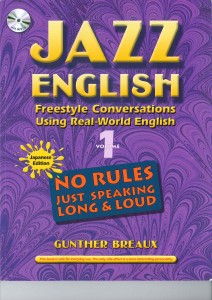EFL eikaiwa high school junior high school Language learning materials reviews speaking teaching textbooks university
by sendaiben
5 comments
Jazz English
Published by Compass, Jazz English is a speaking textbook for lower-intermediate students. It works very well with junior high school students that have been studying for a while and are ready to take things to the next level in terms of speaking, as well as with high school and I imagine lower level university students. I have only used the first textbook, so this review does not address Jazz English 2, nor the companion workbook (which I am going to try soon).
The textbook consists of ten main units and three supplementary ones, with all units following the same pattern: new vocabulary, conversation prompt questions, a dialogue, a short reading section, a crossword to practice the vocabulary, a short reading task, exercises to support speaking, and a final speaking activity.
The focus of the book is for students to develop more autonomy while speaking, and to try to have longer and more complex conversations. It does this very well, at least in my experience, with students that have a solid base of vocabulary and English exposure, and who are motivated to improve their conversational skills. Our ‘advanced’ classes, consisting of junior high and high school students that have been studying for four or more years took to it very well.
This has been a real find for us this year, and I wholeheartedly recommend it for classes similar to the one described above. The course requires a lot of student input, so this book would not work well with unmotivated or reluctant learners.
Anybody else using Jazz English?
Can you tell me where you ordered it from and how much it cost?
Thanks

I’ve just started using Jazz English with some high school kids and, generally speaking, am quite pleased with it. The book does seem to get them talking more and works well in helping to develop longer conversations. But a couple of minor things annoy me about it. The first is the author’s insistence on using ‘Did you ever …’ where ‘Have you ever…’ would be more appropriate. Of course, ‘Did you ever…’ is sometimes a perfectly acceptable and correct usage, but it is not synonymous with, ‘Have you ever…’ as seems to be suggested in the book. There are also other aspects of English which seem to reflect the author’s personal preferences and opinions rather than reflecting more widely used English. I have the book open now, and on the page in front of me it says that ‘I have no clue’ is casual English and ‘I have no idea’ is formal English. It’s not, though – they are simply phrases meaning the same thing but whose use is based more on regional differences than formality.
There are typos too. The very first Real-World Dialog has this: ‘My mom is a nurse, but she just works.’ The CD says ‘…just works part-time’ but the text simply omits those words leaving a meaningless sentence. A Free Talking Frenzy question in Unit 8 is this: ‘Do you prefer to casual or dress up parties?’ which doesn’t make sense.
I’m nit-picking, but these small things are annoying. This is a good book, but it could be really good if the editing and proofreading were a bit more thorough. Overall, though, I would have to say I like it and would recommend it for classes where the primary aim is to have students talk as much as possible in class.